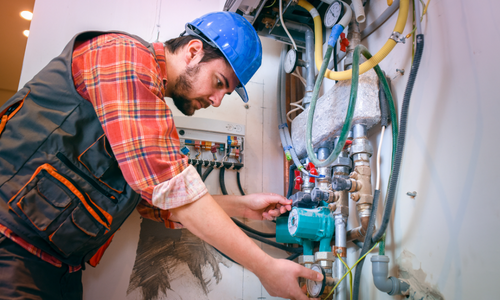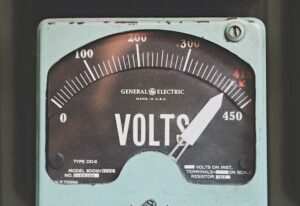Winter can be a beautiful season that brings a lot of joy and content to some. However, it also brings colder temperatures that make us rely on our heating systems to keep us warm and comfortable. So what happens when our heating system fails or isn’t functioning properly?
This is where the emergency heat setting comes into play. In this article, we’ll explore what an emergency heat system is and when and how to use it during the winter season.
What is emergency heat?
Take a moment to learn what emergency heat is before we get into answering “when should you use emergency heat setting” and the benefits it provides.
If your main heating source is damaged or malfunctioning, the emergency heat will switch on automatically. You can keep your house toasty even on the coldest winter days with the aid of a backup heating system.
The “EM HEAT” setting on the thermostat is the emergency heat setting for most central heating systems. As soon as you activate the emergency heat setting, the system stops using the main heat source and begins using the backup system instead. Because of the inefficiency of most emergency heating systems, they should only be used as a secondary heat source in the event of a power outage.
What are the benefits of emergency heat setting?
While it should only be used in emergency situations, the emergency heat setting has significant advantages. Here, we’ll look at the general advantages of emergency heat setting.
A reliable backup system
One of the most important advantages of the emergency heat setting is that it acts as a dependable backup system. If your main heating system breaks or isn’t working properly, emergency heat may come in and keep your house warm.
This is particularly crucial during the winter, when temperatures may dip dangerously low. The knowledge that you have a backup system in place in case of an emergency may bring peace of mind.
Keeps you warm in freezing temperatures
During instances of severe cold, emergency heat is very important. If your primary heating system is having difficulty keeping up with the demand for heat in frigid weather, emergency heat may supplement your primary system and keep your house warm and pleasant. This is especially useful for homes with small children or older family members who are more vulnerable to the cold.
Simple to use
Using emergency heat is simple and straightforward. Most thermostats contain an emergency heat setting, often labeled “EM HEAT,” that you may use if necessary. When you switch on emergency heat, the backup system kicks in and your house begins to warm up. Because there are no difficult installations or major repairs required, emergency heat is a simple and affordable solution for households.
Cost-effective
While emergency heating is often less energy efficient than main heating, it might be a cost-effective solution under specific circumstances. For example, if your main heating system fails and you want a temporary solution, emergency heat may be less expensive than purchasing a new system or completing costly repairs.
Emergency heat is also a good alternative for homes that only suffer severe cold weather a few weeks out of the year, since it may complement your main system while keeping your energy expenses in check.
Aids in the prevention of frozen pipes
Aside from keeping you warm, emergency heat may help avoid frozen pipes. When temperatures go below freezing, the water in your pipes might freeze and break, resulting in costly repairs. This may be avoided by keeping your house warm and avoiding the temperature inside from dipping too low. You may prevent the trouble and expense of dealing with frozen pipes by utilizing emergency heat.
Increases the resale value of a home
Finally, having an emergency heating system installed might boost the market value of your property. Potential purchasers may consider emergency heat to be a useful feature, particularly in places with severe cold weather. Having emergency heat already installed may save purchasers the time and money it takes to install a backup heating system themselves, making your house more appealing to buyers.
Conditions under which it is NOT appropriate to use emergency heating
Even though having access to emergency heat in the cold might mean life or death, it is crucial to recognize when it is not necessary. Some examples of why it’s not a good idea to turn on the emergency heater are:
Continuous application
Earlier in the article, we established that emergency heating is meant to be a secondary system, not the main one. It’s not a good idea to rely on it as a regular heating source since it uses more energy and money.
Temperatures are somewhat cold

To avoid the need for emergency heat, consider moving to a warmer climate. In a well-insulated house, the primary heating system should be sufficient to maintain a comfortable temperature all winter long.
Incorrect temperature due to a broken thermostat
Your emergency heat setting might be activated unnecessarily if your thermostat is malfunctioning. Emergency heat should only be used if your thermostat has been verified to be in working order.
How to use emergency heat?
Here’s what to do if you find yourself in need of emergency heat:
1. Switch to emergency heat mode
Find the “EM HEAT” setting on your thermostat and activate it.
2. Get in touch with a qualified expert
It’s best to call in a qualified expert such as Autumn Air for repairs if your main heating system is malfunctioning. Repairing your main heating system without delay will save you from having to use backup heating for too long.
3. Take caution while using it
It is important to only use the emergency heat source when absolutely necessary. Keep in mind that it is less efficient and more costly to operate than the major heating system, therefore, it is better to switch back to the primary heating system as soon as possible. You should return to using your main heating source after it has been fixed or begins to work properly.
4. Conserve energy by keeping an eye on your energy habits
It’s important to keep an eye on your energy use, especially if you have an emergency heating system installed. If the main heating system is functioning well, you should switch back to it and keep an eye on your power bill.
Endnote
Emergency heating is convenient in a pinch, but If you want to keep your power costs predictable, you should always use the main heating system again as quickly as possible and keep track of your energy use. If your main source of heat is malfunctioning, it’s important to have it fixed as soon as possible by a qualified expert such as Autumn Air, so you don’t have to depend on backup heating for too long.
You can call Autumn Air at (602) 266-5247 or click here to book your appointment.















